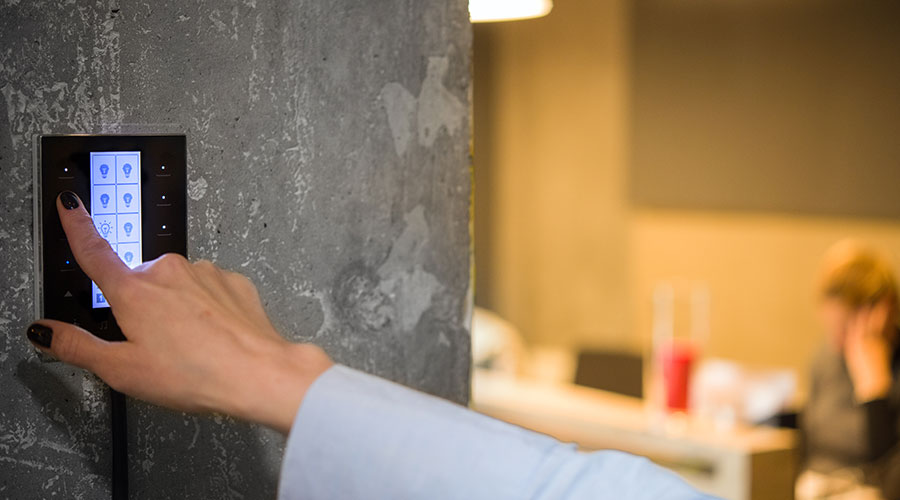Changes in Technology, Legislation and Codes Improve Safety and Security Lighting
Awareness of security measures in the facilities industry has been heightened since the attacks on Sept. 11, 2001. Because lighting is a key element of any security design, it has become a major focus for upgrades in existing buildings.
“Guideline for Security Lighting for People, Property and Public Spaces,” published by the Illuminating Engineering Society of North America in 2003, established direction for the design and implementation of security lighting systems.
Additionally, legislation requiring lighting for safety has been strengthened over this same time frame with an increased emphasis on exit and emergency lighting fixtures. The National Fire Protection Association (NFPA) code and International Building Code (IBC) are both updated in three-year cycles. The last two editions of both codes have featured significant changes about exit and emergency lighting requirements, directing upgrades to existing buildings.
“The clear intent of these guidelines and legislative efforts is to provide safer interior and exterior environments,” says Mark Lien, director of Lighting Solutions Center at Hubbell Lighting. “People feel safer when spaces are illuminated properly. The heightened awareness of the need for improved safety and security lighting should improve our quality of life.”
Changes in Technology
Concerns about sustainability and energy efficiency have also begun to reshape the way interior and exterior safety and security lighting systems are designed and specified. Many existing buildings still use low-efficiency mercury-vapor lighting systems.
The Energy Policy Act (EPAct) of 2005 dictated that no new mercury vapor ballasts can be manufactured or imported into the United States as of Jan. 1, 2008. Once existing inventories of ballasts are gone, no more will be available. The law does not affect the manufacture or importing of mercury vapor lamps.
“Metal halide and high-pressure sodium (HPS) systems will provide more energy efficient solutions,” says Susan Anderson, manager of energy relations at OSRAM SYLVANIA, noting that more legislative changes lie ahead.
Specifically: The federal Energy Independence and Security Act (EISA) of 2007 will regulate the efficiency of ballasts used in metal halide luminaires manufactured as of Jan. 1, 2009. Metal halide ballast efficiency standards established by this act will drive the use of pulse-start systems over the traditional probe-start technology found in older installations.
According to Anderson, pulse-start technology improves lamp performance, particularly in the area of lumen maintenance over lamp life. As lumen maintenance improves, lower wattage systems can be used to achieve the same maintained light levels, reducing energy use. Light quality also factors into the efficiency equation.
“Efficient light doesn’t have to be yellow anymore,” says Susan Bloom, director of corporate communications for Philips Lighting Company and Advance. “In the past, low- and high-pressure sodium sources were the primary high-efficiency options for security lighting. At low light levels, however, yellow light is harder for the eye to process and makes it more difficult to distinguish colors. A range of high-efficiency white light options at different color temperatures is now available for safety and security applications based on HID, fluorescent and LED technology. Studies have shown that white light not only enhances visibility, but it makes people feel more comfortable and at ease as well.”
These newer white light options with improved optics can focus light more precisely in public spaces, outdoor areas and other areas requiring increased light levels for safety and security purposes. They also contribute significant energy savings.
Other Considerations
The creation of a safe and secure environment isn’t just about the amount of light, however. Lighting controls have continued to play an integral role in the evolution of safety, security and outdoor lighting over the past decade.
“Overlighting is wasteful, but more importantly it can create glare and discomfort, which work against a safe environment,” Bloom says. “An ideal environment has light in the right place and at the right time based on the activities taking place. This can be done with everything from simple and inexpensive motion detectors and photocells to intelligent lighting control systems that are integrated with other security equipment, such as security cameras, within a building.”
Lighting design also plays a key role in supporting functional safety, as well as ensuring a secure atmosphere. Over the past five to 10 years, designs have moved from high power lamps covering wide areas, which often create issues with glare, to a more distributed lighting configuration that is both functional and pleasing to the eye. LEDs add new, quality lighting options, including choices for emergency exit and pathway lighting.
Technology continues to improve, and innovations involving LEDs will offer new opportunities for lighting applications, as well as dynamic control options. Design trends will continue to evolve with these and other emerging solid state technologies.
Finally, the past decade has witnessed an increasing popularity in the use of more efficient light sources that operate when and where needed.
“This has led to reductions in power consumption, which are positive developments for an end user’s electric bill, as well as for the environment,” Bloom says. “When contemplating improvements, end users should familiarize themselves with the market’s broad range of options or consult with a knowledgeable and accredited lighting professional.”
Lighting technology now has the capability to improve the safety and security of indoor and outdoor spaces while using significantly less energy than was possible just a few years ago. Now is the time to evaluate lighting systems to save energy and improve safety.
Related Topics:















